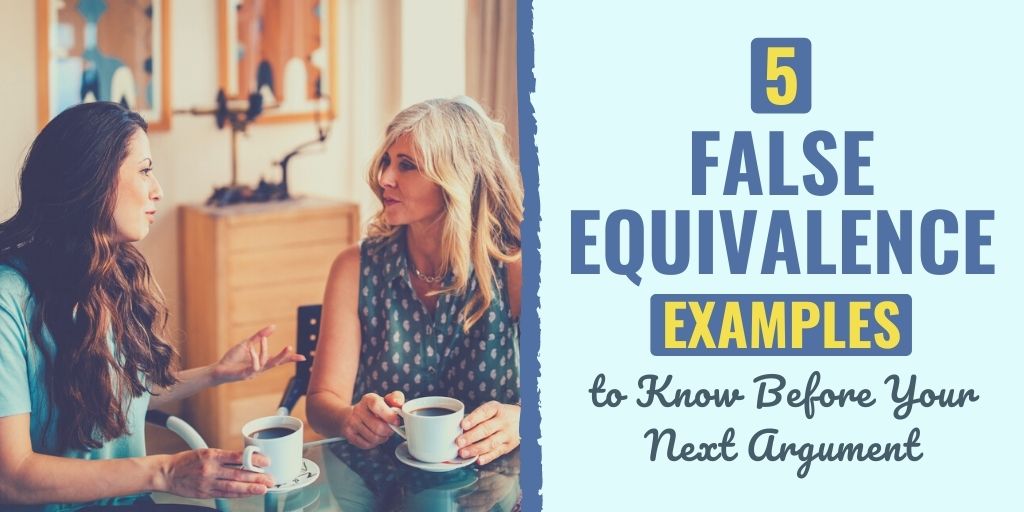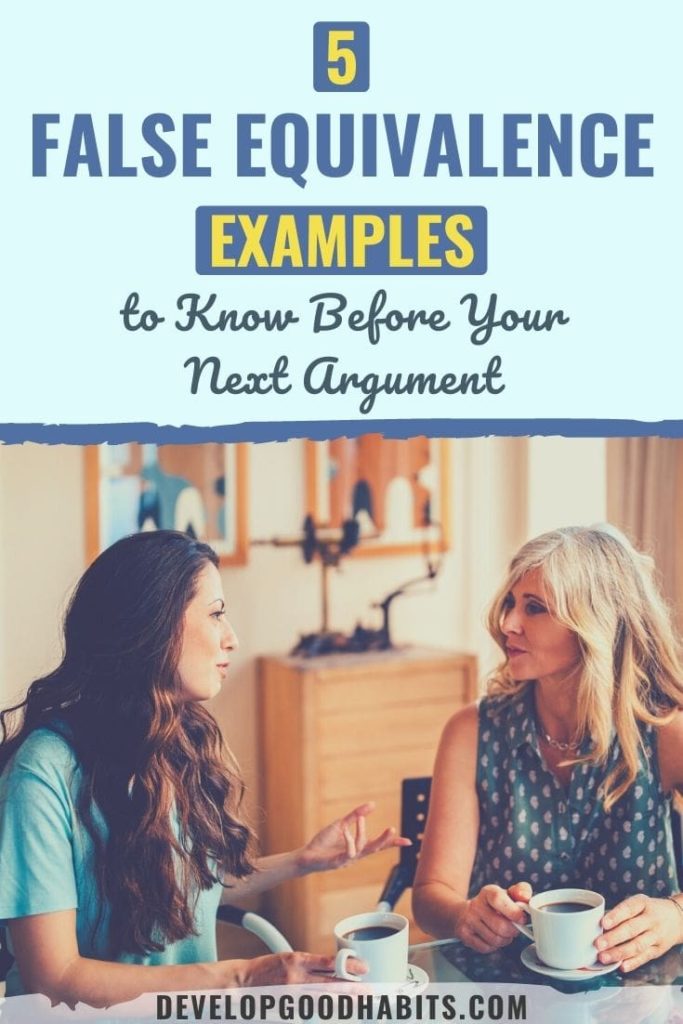There might be affiliate links on this page, which means we get a small commission of anything you buy. As an Amazon Associate we earn from qualifying purchases. Please do your own research before making any online purchase.
In general, drawing comparisons between things can be useful. However, comparisons are not always apt and we sometimes end up drawing comparisons between things that are actually not alike.
A false equivalence is a type of logical fallacy in which a person attempts to draw an equivalence between two things based on the presence of a few shared features when those two things are not alike in the relevant respects. False equivalencies are a type of fallacy because they exaggerate the similarities or downplay the differences between two or more things in order to draw some kind of comparison.
False equivalencies are a broad category of fallacies and can be used to draw comparison between many types of things. False equivalencies are especially common in debates on ethics, where they are used to draw moral equivalences between two things.
What Makes an Equivalence “False”?
Let’s take a look at a simple example of a false equivalence.
“Dogs have tails and feet, and cats have tails and feet. Therefore, dogs are equivalent to cats.”
It is obvious to see why this argument falls flat. Simply the fact that two things might have similar properties does not mean they are equivalent in all respects. The fact that both dogs and cats have tails and feet in no way guarantees that they are equivalent or even alike in any other way.
The above argument is intentionally absurd to help identify the fallacy. But it can be hard to spot false equivalencies in the wild. Consider this argument:
“Taxation is morally equivalent to theft because they both involve taking property with the threat of violence.”
Bob is drawing a moral equivalence between theft and taxation because they share some similar features; e.g they both involve someone taking something from you with either an implicit or explicit threat of violence.
However, one could argue that this argument commits a false equivalence because theft and taxation are not similar in the relevant respects. Theft involves taking without agreement or without compensation. Taxation is something decided on by a democratic government and you are compensated by the things that the taxes pay for. The two things are different enough that they are not actually morally equivalent.
In general, an equivalence is “false” when:
Whether or not the two things being compared are similar enough in the relevant respects depends on the context of the specific debate. For instance, in a discussion about global slavery in general, it may be appropriate to draw some equivalencies between the experiences of white slaves and black slaves. However, in the context of a discussion about US slavery specifically, drawing such an equivalence may not be justified.
The basic idea behind a false equivalence is captured by the common phrase “you can’t compare apples to oranges.”
Logical Form of False Equivalences
Here is the standard logical form of a false equivalence fallacy.
Alternatively, in the case of moral equivalencies, the form looks something like this:
When put into symbolic form, it is easy to see why this argument pattern is invalid. The mere presence of similarities between two things is in no way a justification to assert that those two things are equivalent. Additionally, the fact that two actions might have superficial similarities does not mean they are morally equivalent, as the context and significance of those actions can differ.
Fallacies of equivalence are not so much fallacies of logic as they are rhetorical fallacies. False equivalences are a common rhetorical trick used to present two viewpoints as equally reasonable when one position is clearly deficient. This kind of “both sides-ism” is particularly pernicious because it trains us to ignore relevant differences between things when convenient.
False equivalencies are often combined with other fallacies. For example, they often come with strawman fallacies by distorting an opponent’s position to draw an erroneous comparison.
5 Examples of False Equivalence Fallacies
1. Gun Control
A very common false equivalence in debates about gun control attempts to equate all kinds of objects that can cause violence as fundamentally the same:
“We can’t ban guns just because they can be used to hurt people. After all, cars can be used to hurt people, so if we ban guns then we would have to ban cars too!”
This argument is fallacious because it draws a false equivalence between guns and cars based simply on the fact that they can be used to hurt people. True, both cars and guns can hurt people. The main difference is that guns are designed specifically to kill whereas cars are not.
Moreover, there is a lot of evidence that a high prevalence of guns is associated with a high incidence of violent crime. The same is not true of cars.
2. Discussions About Racism
False equivalencies are often deployed in discussions about racism as a way to minimize and deflect away from the experiences and suffering of oppressed groups, or to deny that systemic racism against minorities in society exists. Here is an example:
“Affirmative action for college admissions is racist. It is racist because it singles people out and makes a decision based on their skin color, which is just as racist as denying minorities based on race.”
This argument draws a false equivalence between affirmative action policies and denying applicants based on race. The idea is that both actions are based on race, so they both must be racist.
The two cases are not equivalent though. Affirmative action programs are meant to address and correct historical racial inequalities. These sorts of race-conscious decisions are not racist because they are not aimed to exclude anyone but make colleges more inclusive. Conversely, denying admissions based on race sustains and furthers racial inequality.
Additionally, affirmative action admissions are not based on race alone, but also other features like academics and socio-economic status.
3. Climate Change
Being a politically charged topic, false equivalencies abound in discussions about climate change. Here is one that you might have heard:
“Many scientists believe that climate change is happening and is caused by humans, but there are those who disagree and think it’s a hoax. So we don’t really know and it’s reasonable to believe either way.”
This is a clear false equivalence because it implies that those who claim that climate change is a hoax have equally compelling evidence as those that think it is real. This is false though; all available evidence points to the reality of anthropogenic climate change and none of it points to it being a hoax. The two positions are in no way equally reasonable and they do not hold equal weight.
4. Veganism/Vegetarianism
Vegans, unfortunately, get a lot of hate online and many false equivalencies get thrown their way on the regular. Here is a very common one:
“Vegans are hypocrites. They claim they love animals but they still kill and eat plants which are living things.”
This is a blatant false equivalence because it draws a moral equivalence between eating animals and eating plants. The two are not similar at all though. True, plants and animals are both living, but plants cannot feel pain and suffering, or at least not nearly to as great a degree as animals.

Moreover, even if plants did feel pain, eating plants and not animals would still minimize total suffering as the majority of plants grown today are used to feed the animals we eventually eat. Vegans care about minimizing suffering and eating a plant-based diet is one way to do that.
5. Politics
False equivalencies, along with slippery slopes and either-or fallacies, are very common in the realm of politics.
“Both candidates A and B did x, y, and z, so they are exactly the same and there is no difference between their actions.”
This argument might initially seem legitimate, but it fails because 2 people could do the same actions but in radically different contexts and scopes. For example, both Joe Biden and Donald Trump threatened to withhold aid from Ukrainian officials. However, Biden did so because Ukraine was not abiding by previously agreed-upon measures to combat corruption. Trump did so to dig up dirt on his political rivals. The context makes the evaluation of the action different.
Responding to False Equivalencies
There are a couple of ways you could go about responding to a false equivalence fallacy. The general strategy is to show why the equivalence is not an apt comparison.
Keep in mind that sometimes, drawing equivalences between things is a perfectly legitimate form of analogical reasoning. You can draw conclusions by comparing two things, as long as those things share features that are relevant to the conclusion you are trying to demonstrate.
For example, drawing an equivalence between animal suffering and human suffering might be acceptable in a debate about the permissibility of animal testing. Whether or not a specific comparison will be legitimate depends on the context.
Final Thoughts on False Equivalencies
Drawing comparisons between things can be a useful form of reasoning but can lead us into fallacious thought. The human brain has a tendency to simplify complex issues, which is why it is so easy to fall into false equivalence fallacies.
However, you can avoid committing a false equivalence by being conscientious with your arguments. You should ask yourself whether you are equating two things with the proper justification. Try to present a counter-example to your own view. That way you will be able to handle false equivalencies when they appear in the wild.
Learn More About Logical Fallacies
- 5 Appeal to Nature Fallacy Examples in Media and Life
- 6 Outcome Bias Examples That Can Negatively Impact Your Decisions
- 7 Self-Serving Bias Examples You See Throughout Life
- 7 Omission Bias Examples That Negatively Impact Your Life
- 6 Authority Bias Examples That Might Impact Your Decisions
- 5 Burden of Proof Fallacy Examples
- 5 Appeal to Tradition Fallacy Examples in Life
- 5 Appeal to Authority Logical Fallacy Examples
- 7 False Cause Fallacy Examples
- 7 Appeal to Ignorance Fallacy Examples
- 7 Appeal to Common Sense Logical Fallacy Examples
- 5 Post Hoc Fallacy Examples (and How to Respond to This Argument)
- Gambler’s Fallacy: 5 Examples and How to Avoid It
- 5 Appeal to Anger Fallacy Examples Throughout Life
- 7 Halo Effect Bias Examples in Your Daily Life
- 7 Poisoning the Well Examples Throughout Your Life
- 7 Survivorship Bias Examples You See in the Real World
- 7 Dunning Kruger Effect Examples in Your Life
- 5 Cui Bono Fallacy Examples to Find Out “Who Will Benefit”
- 6 Anchoring Bias Examples That Impact Your Decisions
- 7 Virtue Signaling Examples in Everyday Life
- 7 Cherry Picking Fallacy Examples for When People Ignore Evidence
- 9 Circular Reasoning Examples (or “Begging the Question”) in Everyday Life
- 9 Appeal to Emotion Logical Fallacy Examples
- 9 Appeal to Pity Fallacy (“Ad Misericordiam”) Examples in Everyday Life
- 9 Loaded Question Fallacy Examples in Life and Media
- 9 Confirmation Bias Fallacy Examples In Everyday Life
- 9 Bandwagon Fallacy Examples to Prevent Poor Decisions
- 5 Red Herring Fallacy Examples to Fight Irrelevant Information
- 9 Middle Ground Fallacy Examples to Spot During an Argument
- 7 Hasty Generalization Fallacy Examples & How to Respond to Them
- 6 False Dichotomy Examples & How to Counter Them
- What is the Planning Fallacy?
- How to Overcome the “Sunk Cost Fallacy” Mindset
Finally, if you want a simple process to counter the logical fallacies and cognitive biases you encounter in life, then follow this 7-step process to develop the critical thinking skills habit.

Alex Bolano is a freelance writer based out of St. Louis. He holds his MA in Philosophy and writes on topics relating to science, culture, politics, finance, and education. He enjoys playing video games and researching the latest trends in science and technology.


